Fitness training for Field Hockey: Part 2
2 CommentsHow to get fit for Hockey
Last week we looked at the fitness demands of hockey, now some tips on how to get fit for hockey.
Strength
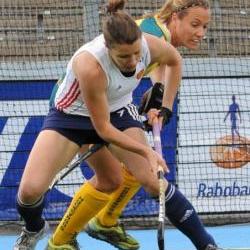
Anne Panter
Strength training should be incorporated into programmes for all ages, this should be appropriate to the athlete and progressive
Initially this should work on movement skills and injury prevention progressing to work capacity.
Movement skills and Injury prevention can be worked on together, a system we use at Excelsior is the 5×5’s.
These 5 exercises are performed for 1 minute a day with a different set of exercises each day.
As discussed when looking at common injuries we need to work on back mobility & strength, hamstring strength, pelvic and knee stability. These are worked on during the 5×5’s but extra attention may be required, example exercises are below:
| Common Injury | Exercise 1 | Exercise 2 (progression) |
| Knee | Single leg squat | Single leg hop & hold |
| Pelvis | Hip Series 1 | Hip Series 2 |
| Back Strength | Bent over row | Pull ups |
| Hamstring Strength | Hip Series 3 | Hip Hinge |
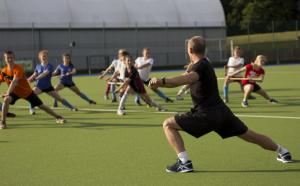
James warming up hockey players
These weaknesses can also be affected by everyday activities for example sitting for prolonged periods at work or commuting, so this needs to be managed with effective warm ups prior to games and training sessions.
Work Capacity
Due to the variety of speeds and distances covered (as shown last week) we coaches need to work the players across the spectrum of intensity levels.
Due to the shortage of time with athletes it is good to work with hockey coaches and utilise time effectively. One example is shown in this video of Maddie Hinch training.
We can do this using small sided games. Within these games we must make sure we are working on the correct energy systems which can be done through medium, high and maximal intensity games.
One problem that can occur is that we don’t allow enough rest in these games which can lead to players working through fatigue and injuries occurring.
Type of Game Percent of Maximum Heart Rate
| Type of game | % max heart rate | Single game duration | Work: rest ratio |
| Medium intensity | 85% | 5-10 minutes | 1: 0.5-1 |
| High Intensity | 85-95% | 5 minutes | 1: 1-1.5 |
| Maximal intensity | 95+% | Upto 2 minutes | 1: 1.5-3 |
Speed & Agility
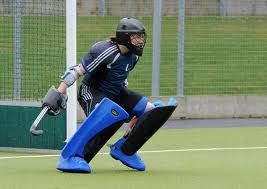 With the high intensities of the current game speed and agility are extremely important for every position.
With the high intensities of the current game speed and agility are extremely important for every position.
In the past this training has consisted of repeated sprints and drills involving lots of equipment possibly without thought of if it is actually working and why not if it isn’t.
When looking to improve speed and agility we first need to look at what areas contribute towards them. Other than technique which is essential we can also work on:
- force production
- movement efficiency
- decision making
We must first make sure the athlete is able to withstand the forces that are applied during training, they should be able to brake before accelerating.
Summary
With the speed of the game increasing due to rule and tactical changes players need to be able to cope with the new demands of what is now almost a professional sport.
As athletic development coaches we need to look at a long term pathway for our athletes which incorporates working on all the demands of the sport.
Want to get fit for Hockey?
- Get fit for hockey by training with us every week in our strength and co-ordination sessions in Willand, Devon.
- or our guide to pre-season here.
Duncan Buckmaster
References
Conditioning for field hockey, Ian Jeffreys, NSCA Performance Journal October 2005


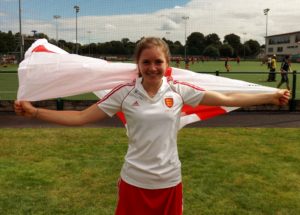
 Heart rate measurements that have been taken show that a players maximum rate can reach 180 bpm indicating hockey being an extremely intense game, average heart rate was around140 bpm.
Heart rate measurements that have been taken show that a players maximum rate can reach 180 bpm indicating hockey being an extremely intense game, average heart rate was around140 bpm.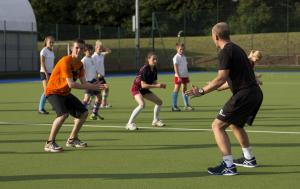 The use of synthetic pitches has also meant a more unstable surface, which in turn means more injuries through twisting and straining ligaments and muscles within
The use of synthetic pitches has also meant a more unstable surface, which in turn means more injuries through twisting and straining ligaments and muscles within 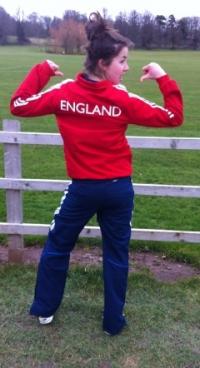 These imbalances can be seen in older players when you look at musculature, one side of the back will have larger muscles while the opposite side will have smaller weaker ones.
These imbalances can be seen in older players when you look at musculature, one side of the back will have larger muscles while the opposite side will have smaller weaker ones. The Christmas break is an ideal opportunity to reflect on how training has gone, if you’ve had any injuries and where you need to improve.
The Christmas break is an ideal opportunity to reflect on how training has gone, if you’ve had any injuries and where you need to improve.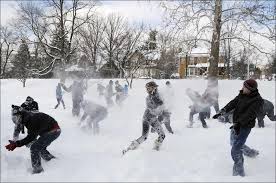 Field hockey is now played almost all year round. Younger players have county and regional training scheduled in the summer. Adults have summer and indoor leagues.
Field hockey is now played almost all year round. Younger players have county and regional training scheduled in the summer. Adults have summer and indoor leagues.